Migrants navigate chaotic, overwhelmed system in New York
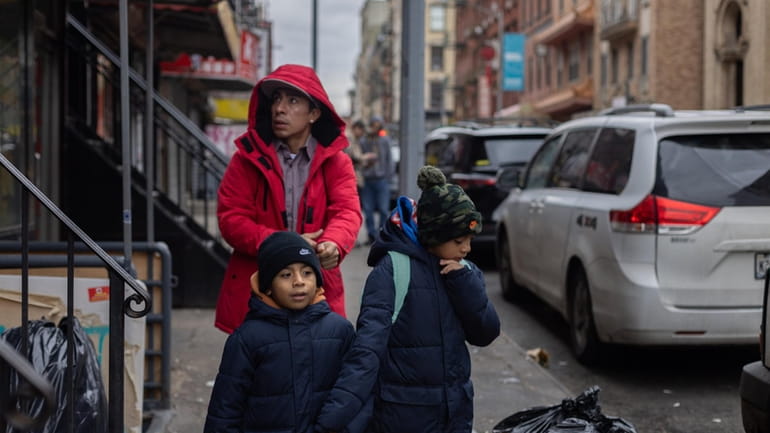
Julio Zambrano and his sons, César, 6, and Julio, 9, walk to an appointment with ICE on Jan. 30. “I want to show up on time for my appointment, so they don’t deport me,” he said. Credit: Jeffrey Basinger
Dozens of migrants crowded near metal fences outside a lower Manhattan office building, some waving documents that told them to report that day for meetings with immigration authorities. But security guards would not let them in.
“ICE is closed,” a guard told Julio Zambrano, his two young sons and others, referring to the U.S. Immigration and Customs Enforcement office. “They’re not taking any more people. Go home.”
Come back at 4 o’clock the next day, a guard told the migrants.
“Four in the afternoon?” one man asked in Spanish.
WHAT TO KNOW
- Migrants arriving in New York face a confusing, sometimes chaotic immigration system. More than 175,000 migrants have been processed by New York City since spring 2022.
- Many of them end up at a federal office building downtown, where some are turned away even if they have appointments, because immigration agencies are overwhelmed.
- Critics of the Biden administration said the president has not done enough to stem migration at the border. Biden criticized Congress for not passing a bill to increase border funding.
“Four in the morning,” a fellow migrant said.
The scene outside the Jacob K. Javits Federal Building on Jan. 30 illustrates the chaos of an immigration system overwhelmed by an unprecedented surge of migrants crossing the border. New York City alone has processed more than 175,000 migrants since the spring of 2022, among the millions who have entered the country legally and illegally in recent years.
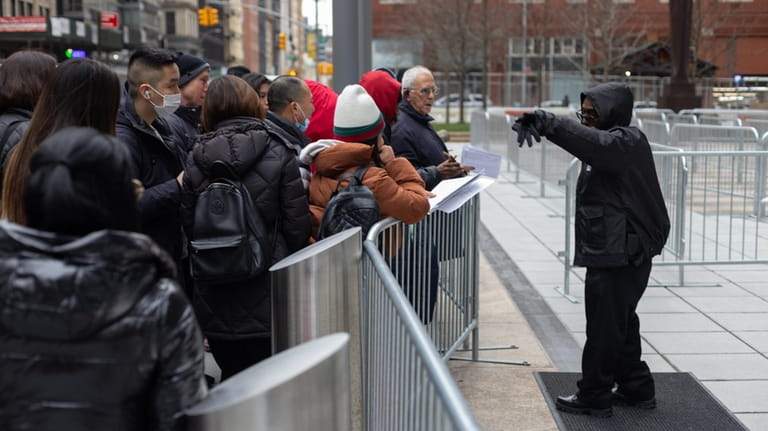
A security guard outside the Immigration and Customs Enforcement office in lower Manhattan on Jan. 30 informs migrants that they can't come in, regardless of whether they have an appointment. Credit: Jeffrey Basinger
One of them is Zambrano, 35, who arrived in New York on Jan. 4 with sons César, 6, and Julio, 9, after a two-month journey on foot and by bus from his native Ecuador.
Newsday first met the three when they emerged from a midtown Manhattan migrant intake center to travel to a city-funded hotel, hours after a bus from the Texas border dropped them off in New Jersey. Now Zambrano is trying to navigate a complicated immigration system, and as he stood outside the gates of the federal building, he and his sons also faced a looming deadline to find a new place to live.
'Too many people'
Zambrano and his children arrived more than a half-hour early for their 11 a.m. ICE appointment. But that was far too late to have any chance of getting in the building.
“If you don’t come at 4 o'clock in the morning — there are too many people,” said a guard, who declined to give his name. “Once they get to a certain number, they stop letting people in. If you don’t come in early, to get in with that 500 or 600 people, you’re not going to get in.”
Migrants showed the guards official ICE paperwork with their appointment times for that morning, pleading to be let through. Their faces, and the tone of their voices, betrayed desperation and fear.
“You’re wasting your time, bro,” one guard said. “Come back tomorrow. ICE is closed.”
The guard, who wore a jacket with a patch from Paragon Systems, which provides security for federal facilities, spoke in English. Other than an occasional few words in Spanish — such as “está cerrado hoy,” meaning “it’s closed today” — guards addressed the mostly Spanish-speaking crowd in English.
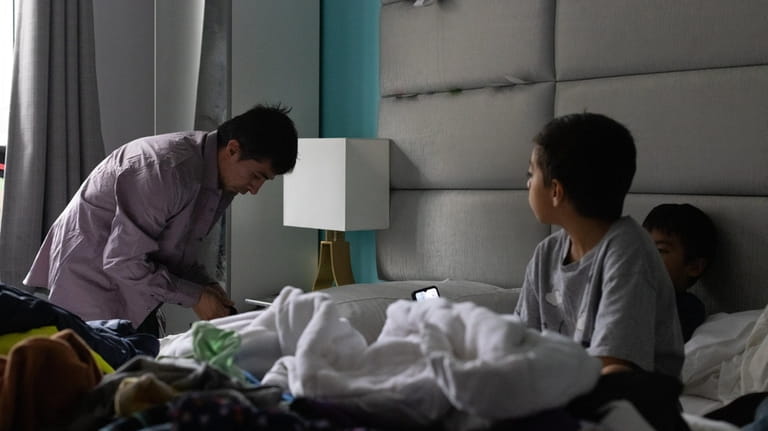
Julio Zambrano getting ready for a meeting with ICE. He arrived more than a half-hour early for his appointment, but was far too late. Credit: Jeffrey Basinger
“I don’t understand,” Zambrano said in Spanish.
A Newsday reporter discovered while speaking with a guard that because Zambrano has children, he could arrive at 6 a.m. instead of 4 a.m. Families with children are let in first.
“So the kids are not so cold,” the guard said.
Another guard warned Zambrano not to be late.
“Pronto,” he said. “Don’t fool around. Because that line gets [long] quick.”
I want to show up on time for my appointment, so they don’t deport me.
—Julio Zambrano
As Zambrano and his sons began a 20-minute walk back to the city-funded Chinatown hotel room where they were staying, other migrants continued to arrive, clutching their own white sheets of paper with now-meaningless appointment times.
Zambrano said he was nervous.
“They’re going to think I didn’t show up for my appointment,” he said.
He planned to leave his hotel early the next morning to get in line.
“I want to show up on time for my appointment, so they don’t deport me,” he said.
Process 'needlessly cruel,' expert says
César, left, and his brother Julio Zambrano play on the bed at the Canal Loft Hotel in Chinatown while their father packs on Jan. 31. Credit: Ed Quinn Credit: Ed Quinn
Zambrano’s appointment was with an ICE duty officer. Such appointments typically are only “check-ins,” to ensure migrants show up and to obtain basic information, said Lauris Wren, a clinical professor of law at Hofstra University in Hempstead and director of its asylum clinic. But, she said, many migrants don’t know what the appointments are for and that their cases likely won't be harmed for not arriving at a single appointment, especially if they return early the next day.
“Put yourself into the shoes of the migrant,” Wren said. “They're terrified at missing anything. And they've tried to do everything exactly right. And now the security guard is telling them, ‘Nope, you can't come in. Sorry about that.’ The process is so difficult, confusing and stressful for everybody involved.”
Wren called the system “needlessly cruel. There should be and definitely could be more humane ways to handle check-ins.”
ICE said in a statement that it “continues efforts to address processing delays at some ICE offices,” including by allowing migrants to schedule appointments and update addresses online — although Wren said many migrants are unaware of those electronic options. The agency did not respond to questions as to why it often turns away people with scheduled appointments and whether migrants are penalized if they don't arrive at the allotted time and date.
If you fail to fund the system, the system is going to break down.
— Andrew Arthur, of the Center for Immigration Studies
Andrew Arthur, a former immigration judge and a resident fellow in law and policy for the Washington, D.C.-based Center for Immigration Studies, which favors more limits on illegal and legal immigration, placed blame for the long lines on President Joe Biden for not using his executive authority to reduce the number of people crossing the border, and for budgets that cut ICE funding.
“If you fail to fund the system, the system is going to break down,” Arthur said. “Julio is a victim of the system breaking down.”
Biden argues he needs congressional approval to get the border situation under control, and he had urged passage of a bipartisan bill that would have funded the hiring of more border personnel, instituted stricter criteria for asylum claims and authorized blocking entry even of asylum-seekers if border crossings rose too high. The Senate on Wednesday shot down the bill after Republican support caved under pressure from former President Donald Trump.
The Department of Homeland Security said in a statement that, since May, the number of migrants removed from the country each day on average is nearly double the daily average from 2014 to 2019.
Not enough lawyers for migrants
Julio Zambrano and his sons, César, 6, and Julio, 9, in their hotel after an attempt to meet with ICE. Zambrano says he applied for asylum after crossing the border in Texas. Credit: Jeffrey Basinger
Zambrano said he fled north with his boys because he was the victim of extortion and threats of violence in Ecuador. He said he asked officials for asylum when he crossed the border a few days before Christmas, and was detained. But he said no one asked questions about his asylum request, and forms he has don't indicate he went through a formal asylum screening.
Officially, Zambrano is in “removal proceedings,” documents show, but he is allowed to stay in the United States until his case is resolved. He is to appear in immigration court in November “to show why you should not be removed from the United States,” a homeland security document indicates.
He does not have a lawyer and can’t afford one.
An attorney is “hugely important” in an asylum proceeding, Wren said.
“We have wonderful nonprofits, but they're not going to be able to cover everybody,” said Wren, whose asylum clinic turns away far more people than it can represent.
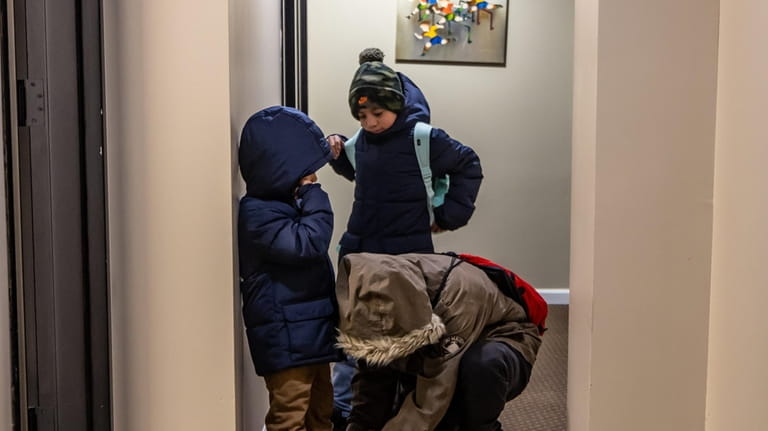
Julio Zambrano and his sons prepare again to meet with ICE. Credit: Newsday/J. Conrad Williams Jr.
Babies and toddlers under layers of blankets
The morning after Zambrano’s fruitless visit to ICE offices, he and his sons tried again. They emerged from the Canal Loft Hotel at 5:40 a.m., walking through the dark, quiet streets of Chinatown and downtown.
When they arrived in front of the Javits Federal Building at 6 a.m., there already were more than 200 people lined up, many bundled in heavy coats to protect themselves from the cold wind, with babies and toddlers in strollers covered by layers of blankets.
Julio Zambrano and his sons arrived before dawn at the ICE office in Manhattan on Jan. 31. Credit: Newsday/J. Conrad Williams Jr.
Zambrano was told to stand in the line for families with children. Credit: Newsday/J. Conrad Williams Jr.
Zambrano showed a guard his papers, and the three were told to stand in the shorter of two lines, the one reserved for families with children.
Most people arriving spoke Spanish, but there also were migrants who told Newsday they were from Senegal, Guinea, China and Jamaica.
As the overcast sky began to lighten toward the approach of dawn, a steady stream of migrants continued to walk toward the metal fences to wait for a guard to inspect their documents.
“Papers out,” a guard said.
Carlos Celis, 28, of Colombia, stood behind about two dozen people outside the fence, with a document that instructed him to report to ICE within 60 days of his Dec. 28 arrival in Texas. He said friends who received similar notices told him he first needed to obtain an appointment, and then return another day. They warned him to arrive early.
Celis said he owned a small market in Colombia and was extorted for 20 million pesos — about $5,100 — by a guerrilla group. That could qualify him for asylum, but he said he didn’t request asylum at the border for “a lack of knowledge.” He said he was let through the border anyway and, after a week in government custody, got on a bus to New York.
He said he is eager to explain his situation to ICE, and to a judge at an April immigration court hearing.
Zambrano and his sons walked into the lobby of the Javits building shortly before 7 a.m. as those without children continued to wait in the cold.
Less than 2 1/2 hours later, he emerged from another door, with the same dejected look he had the previous morning.
No one’s going to give me work with this ... Only criminals and bad people have these.
—Julio Zambrano
“They didn’t ask me anything,” he said. “They told me to come back in November,” for his court date.
The immigration official wrote in red pen that he had attended his meeting, and typed something into a computer, Zambrano said.
“The good thing is I showed up,” he said.
Zambrano was disappointed that his request to remove the ankle bracelet with GPS tracking that an immigration agent had clamped onto his left leg in Texas was denied.
“No one’s going to give me work with this,” Zambrano said after leaving the federal building. “Only criminals and bad people have these.”
A rushed exit to a new hotel
César Zambrano, 6, and his father Julio prepare to leave their hotel in Chinatown. Credit: Ed Quinn Credit: Ed Quinn
After leaving the federal building, he had another urgent task. The family's 28-day stay at the Canal Loft would expire the following day. So he and his sons walked to a nearby subway station to return to the main city migrant intake center, in the former Roosevelt Hotel in midtown, to obtain new housing.
Inside the 100-year-old building, the three sat in cavernous room under chandeliers surrounded by stately columns. Zambrano sent videos to a reporter of the hundreds of others — he estimated more than 500 — waiting with them.
“I’m losing my patience,” Zambrano said in a WhatsApp voice message at 3:52 p.m., six hours after he arrived. “I’ve been here since the morning and still no one has helped me.”
About a half-hour later, he received a reservation for another 28-day stay.
“I asked them, ‘Please don’t send me too far,’ ” he said. “And they sent me to the Bronx.”
Zambrano said he told them he wanted to enroll his children in a school in Chinatown and had yet to do so because he didn’t want them to change schools and was awaiting the arrival of vaccination records from Ecuador.
“They told me there are schools there [in the Bronx] that are free, that my sons’ studies are free,” he said. “What else can I do, if they’re offering me a roof over my head? I have to accept. I have to go.”
Zambrano said he was told he had to leave that night.
“I asked if I could pack my things tonight and go tomorrow morning, and they said no, I’d lose my room,” he said.
It’s important to know we’re very much out of space.
—Kayla Mamelak, spokeswoman for New York City Mayor Eric Adams
A spokeswoman for New York City Mayor Eric Adams, Kayla Mamelak, said all families with children immediately receive new placements. There would have been a different room available if Zambrano had returned to the Roosevelt the next day, she said.
Families with children in shelters and hotels run by the city can stay in the same place for the first 60 days, but those who receive city-funded rooms through a hotel association receive vouchers for 28-day stays, she said. Adults without children have an average wait of eight days for new housing after hitting a 30-day limit, she said.
The city tries to avoid disrupting children’s education, but other than that, the city sends migrants wherever there is a room, she said.
“It’s important to know we’re very much out of space,” Mamelak said.
In his nearly four weeks at the Canal Loft, Zambrano had begun to access services nearby. Friends he made at the Canal Loft told him about free hot meals to supplement boxes of food he received from the city, and of giveaways of clothes and fresh fruit. They directed him to a Catholic Charities office, where he was assigned a social worker.
Now, at his hotel in northeastern Bronx, he worried about starting anew to look for assistance.
To the Bronx
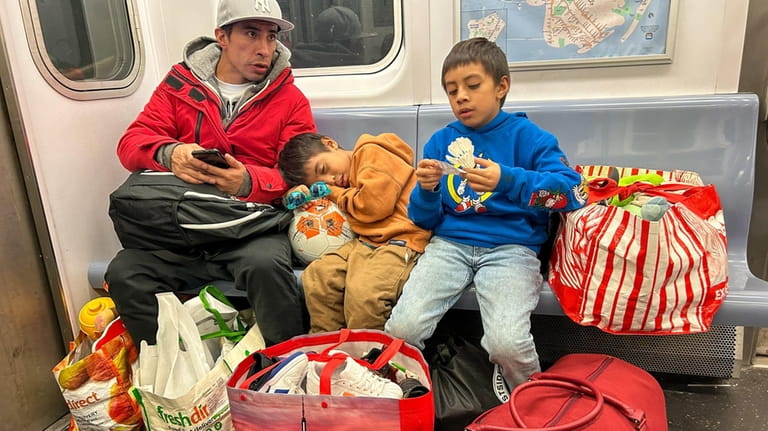
Julio Zambrano, with his sons César, 6, center, and Julio, 9, ride the subway on the night of Jan. 31 surrounded by their possessions. Credit: Ed Quinn Credit: Ed Quinn
Zambrano and his sons began their long journey from Chinatown to the Bronx by walking to a subway station, almost the same route in the dark they had trekked 14 hours earlier to their immigration appointment. This time they were laden with canvas and reusable plastic bags filled with donated clothes and other possessions.
On the 5 subway train, the younger Julio hugged a stuffed green frog while César fell asleep on his father’s left leg.
At 9:30 p.m., an hour and 40 minutes after leaving the Canal Loft, they walked into the seven-story, 56-room orange-and-blue Royal Hotel Bronx.
They checked in with a man who stood behind a thick plexiglass barrier.
Zambrano opened the door to his room. His face was glum. It was smaller than the one in Chinatown, and there was only a queen bed and two pillows for the three of them, instead of the king-size bed they slept in at the Canal Loft. The wall between the bed and bathroom was scuffed up with black marks.
Twenty-seven days earlier they had arrived in New York City, uncertain what to expect. Now their lives had been uprooted again. At the end of the month, they may need to find another place to live.
But Zambrano said he had no regrets. He was happy to be in New York, and appreciative of the assistance he’s received from the city, nonprofits and others.
“I’m still very grateful,” he said, “because they’ve welcomed us, have given us a roof, given us food. They’ve given us a lot of help.”
Julio Zambrano, with his sons on the morning of Jan. 31, says he has no regrets. Credit: Newsday/J. Conrad Williams Jr.
Two body parts suspects in court ... Teen chicken keeper ... Rangers advance ... Penn upgrades
Two body parts suspects in court ... Teen chicken keeper ... Rangers advance ... Penn upgrades

